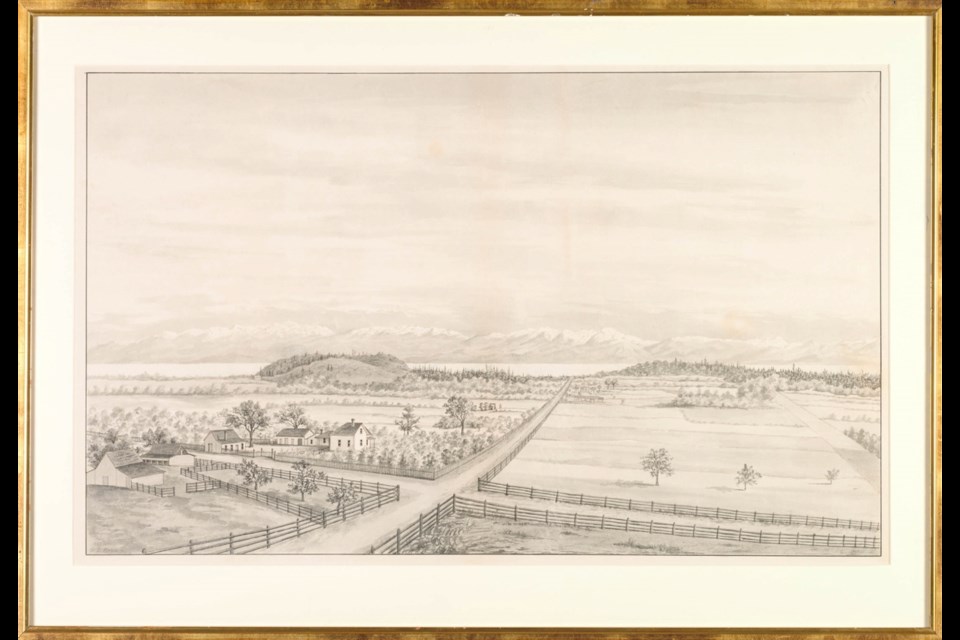 John Lutz, head of the history department at the University of Victoria, has a passion for our past. His research into the life and work of Grafton T. Brown, who lived and worked here in 1882 and 1883, is the subject of a new exhibit at the Legacy, the university’s downtown exhibition space.
John Lutz, head of the history department at the University of Victoria, has a passion for our past. His research into the life and work of Grafton T. Brown, who lived and worked here in 1882 and 1883, is the subject of a new exhibit at the Legacy, the university’s downtown exhibition space.
Brown was considered in his day as “the first professional artist to work in this province,” though that opinion neglected Paul Kane, who was here in 1843, and W.G.R. Hind, living in Victoria from 1863 to 1870. Brown arrived here in 1882 from San Francisco.
His professional work in California included elaborate bill heads and share certificates for the booming silver mines, and also “bird’s eye” views of the mining towns. These artistic products are avidly collected south of the border, where he has a considerable reputation.
After arriving in B.C., he ventured up the Fraser and Thompson rivers with a survey party working for the 91ԭ�� Geological Survey and, returning to Victoria, spent the next year painting up his sketches, and drawing commissioned views of local homes and gardens.
After years of success as a printer, Brown had switched to “fine art,” and took his place in Victoria society at a new, higher level. During November of 1882, Brown opened his studio in the Occidental Hotel on Wharf Street, where he displayed his survey sketches “with the exquisite tints of autumn on the foliage, which give the landscapes a rich warm colouring,” as the Daily British 91ԭ�� explained at the time. “He is proposing to do those pictures in watercolours and will furnish any of them to order.”
As well as views from his surveying trip, his subjects included Mount Baker, Victoria and Esquimalt harbours and Portage Inlet when, in June 1883, 22 paintings were featured in a one-week exhibition, at the “new 91ԭ�� building” on Government Street. The lieutenant-governor purchased Twilight on the South Thompson River.
Fortunately, the paintings were photographed at the time, and our provincial archives has a copy of the album. For the current show, Lutz has assembed nine originals, including four from the Royal B.C. Museum and Archives, one from Craigdarroch Castle, one from the Art Gallery of Greater Victoria, two from private collections, and an unusual painted plate that might — or might not — be Brown’s work. In addition, reproductions of some of Brown’s graphic work are included.
Brown was a talented, but essentially untrained, oil painter. His field work might have resulted in sketches or plein-air paintings, but none have surfaced. The resulting oils are Brown’s version of the awe-inspiring views of the American West, as painted by luminists of the Hudson River School, such as Frederick Church and Albert Bierstadt. The “exquisite tints of autumn” in Brown’s paintings bring to mind the brown tones of varnish so common of 19th-century oils.
In this show, a marine view of the entrance to Victoria’s harbour (which appears on page D1) is clear and vividly painted. The paint handling of the major elements, such as clouds, waves and branches, is rather formulaic. A writer in the Washington Post in 2004 noted Brown’s “certain awkwardness” and that his perspective is “frequently off.” At its worst, Brown’s painting has a touch of the tame romanticism of television painter Bob Ross.
The efforts of Brown in Victoria were soon superseded by more talented painters. In 1886, C.A. de L’Aubiniere and his wife Georgina stopped in Victoria long enough to create a suite of beautiful oils and watercolours, which were commissioned as the province’s gift to Queen Victoria for her jubilee.
When the 91ԭ�� 91ԭ�� Railway was completed in 1887, it was carrying the first president of the Royal 91ԭ�� Academy, Lucius O’Brien, who brought his academic training and precise topographical realism to bear on Mount Baker.
While he was here, Grafton Brown accepted commissions to make detailed studies of pioneer homesteads and their expansive settings. The current show features a wash-drawing of the Dean farm, its crisply drawn farmhouse and various outbuildings situated on Shelbourne Street near Bay. They are fastidiously fenced about, with a view looking south all the way to the Olympic Mountains.
The flavour of the times is evident in the ornate gilded framing on these period pieces. The simple wooden structure was, at the time, covered with elaborate plaster mouldings and granular material sprinkled about, with the whole given a covering of brassy gold leaf.
One can easily imagine a painting signed G.T. Brown quietly passing a century in the upstairs back hall of some big Rockland mansion. With prices reaching considerable levels in the U.S., more of Brown’s 91ԭ�� paintings might turn up.
After a season in Victoria, Brown moved on. In 1884 he was resident in Tacoma, Washington, and then followed his business prospects to Portland and Yellowstone. His extensive commercial career before and after Victoria is recorded in Robert J. Chandler’s book titled San Francisco Lithographer — American Artist Grafton Tyler Brown (University of Oklahoma Press, Norman, Oklahoma, 2014).
Lutz’s efforts in bringing Brown’s Victoria chapter to light are appreciated by students of local art history.



